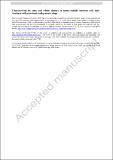Characterizing dry mass and volume changes in human multiple myeloma cells upon treatment with proteotoxic and genotoxic drugs
Author(s)
Liu, Xili; Moscvin, Maria; Oh, Seungeun; Chen, Tianzeng; Choi, Wonshik; Evans, Benjamin; Rowell, Sean M.; Nadeem, Omar; Mo, Clifton C.; Sperling, Adam S.; Anderson, Kenneth C.; Yaqoob, Zahid; Bianchi, Giada; Sung, Yongjin; ... Show more Show less
Download10238_2023_1124_ReferencePDF.pdf (1.727Mb)
Publisher Policy
Publisher Policy
Article is made available in accordance with the publisher's policy and may be subject to US copyright law. Please refer to the publisher's site for terms of use.
Terms of use
Metadata
Show full item recordAbstract
Abstract
Multiple myeloma (MM) is a cancer of terminally differentiated plasma cells. MM remains incurable, but overall survival of patients has progressively increased over the past two decades largely due to novel agents such as proteasome inhibitors (PI) and the immunomodulatory agents. While these therapies are highly effective, MM patients can be de novo resistant and acquired resistance with prolonged treatment is inevitable. There is growing interest in early, accurate identification of responsive versus non-responsive patients; however, limited sample availability and need for rapid assays are limiting factors. Here, we test dry mass and volume as label-free biomarkers to monitor early response of MM cells to treatment with bortezomib, doxorubicin, and ultraviolet light. For the dry mass measurement, we use two types of phase-sensitive optical microscopy techniques: digital holographic tomography and computationally enhanced quantitative phase microscopy. We show that human MM cell lines (RPMI8226, MM.1S, KMS20, and AMO1) increase dry mass upon bortezomib treatment. This dry mass increase after bortezomib treatment occurs as early as 1 h for sensitive cells and 4 h for all tested cells. We further confirm this observation using primary multiple myeloma cells derived from patients and show that a correlation exists between increase in dry mass and sensitivity to bortezomib, supporting the use of dry mass as a biomarker. The volume measurement using Coulter counter shows a more complex behavior; RPMI8226 cells increase the volume at an early stage of apoptosis, but MM.1S cells show the volume decrease typically observed with apoptotic cells. Altogether, this cell study presents complex kinetics of dry mass and volume at an early stage of apoptosis, which may serve as a basis for the detection and treatment of MM cells.
Date issued
2023-07-08Department
Massachusetts Institute of Technology. Laser Biomedical Research CenterPublisher
Springer International Publishing
Citation
Liu, Xili, Moscvin, Maria, Oh, Seungeun, Chen, Tianzeng, Choi, Wonshik et al. 2023. "Characterizing dry mass and volume changes in human multiple myeloma cells upon treatment with proteotoxic and genotoxic drugs."
Version: Author's final manuscript